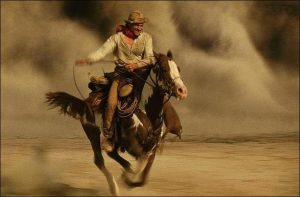HIDALGO, THE SPANISH MUSTANG HORSE THAT WROTE HISTORY.

The film “Hidalgo” has undoubtedly been watched or at least heard about by everyone. It is one of the most amazing western movies ever made that shows the incredible story of cowboy Frank T.Hopkins and his loyal mustang Hidalgo. They are invited in 1890 by a wealthy sheik to compete in the “Ocean of Fire” – the most challenging race ever made in the Arabian desert. After Frank Hopkins accepts the invitation to participate in this unbelievable race there begins an epic battle between the American rider and all the Bedouin riders with their strong Arabian horses. Hidalgo is a Spanish Mustang, a magnificent horse breed that was imported from Spain during the early conquest of the Americas.

This kind of breed nowadays is extremely rare in Spain and they are listed within the larger grouping of the Colonial Spanish horse. Spanish Mustangs are occasionally confused for the wild American Mustang even though they are domesticated horses nowadays. The following species live in protected Herd Management Areas (HMAs) in the western United States, which are actually controlled by the Bureau of Land Management (BLM), and to a lesser degree, in Canada. They are descended from both Spanish and other wild horses who escaped from diverse sources.

The real Spanish Mustang as a modern breed changes from the “wild” American Mustang in features and heritage. The breed was preserved and saved from extinction by the preservation breeders and the conception of a registry to protect and maintain the original type. Even though they were excited to familiarize the public with this exceptional breed, the main purpose of the Spanish Mustang Registry is to ensure the preservation of the characteristics that provided this unique horse to survive over the centuries under unfavorable conditions. Spanish Mustang breeders and owners may proudly and honestly claim that the breed’s preservation has been achieved without losing its historical value or originality.

The Spanish Mustangs are now as they always have been and the main principle of the Spanish Mustang Registry is that there will be no attempts to crossbreed or to differently change these historical and peculiar animals. They were recognized as the most elegant horses in the known world at the time of the conquest of the New World and they made sure to leave a legacy in its strong, fine, brave descendants that continue to this day. Environmental conditions must absolutely have played a role in the evolution of these horses over many periods.

Though the Spanish Horse was not a wild animal when it landed in America, once set free it managed not only to survive but to flourish in the New World, which proves once again the versatility and energy of the breed. The final outcome is a remarkably strong and firm horse displaying the ability to perform in almost any equine discipline and perform well. The staying strength and persistence of these Spanish descendants are legendary.

Frank Hopkins, the famous endurance rider in the latter part of the 1800s, a rider of Spanish Mustangs, is quoted as saying “You can’t beat mustang intelligence in the entire equine race. These animals have had to shift for themselves for generations. They had to work out their own destiny or be destroyed. Those that survived were animals of superior intelligence. The modern Spanish Mustang has all the traits that were previously found in their ancestors.

Spanish Mustangs are still strong and resilient enough to travel vast distances without becoming unduly tired. They are remarkably courageous creatures and less prone to injury than other breeds, especially to the legs and feet. These beautiful horses were introduced to the United States by Columbus on his second voyage to the New World. They are 13.2 to 14.3 hands tall, weigh about 600 to 900 pounds, and are famous for their versatility, intelligence, and stamina.

They are manifesting themselves in the modern horse world in longevity, dressage, jumping, driving, and ranching activities. Although they are recognized little horses by today’s standards, they can carry up to 30% of their body weight and are very adaptable for both children and adults. The Colonial Spanish horse is supposedly the most fascinating breed. The whole color spectrum of roan and thick skin, including dun, buckskin, sorrel, gray, and black, is displayed. Appaloosa, overo, tobiano, and sabino marks are common.
Video:




